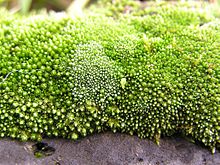bryophyte
English



Etymology
From Bryophyta, from (deprecated template usage) [etyl] Ancient Greek βρύον (brúon, “moss”) + φυτόν (phutón, “plant”) ( + -phyte).
Pronunciation
- Lua error in Module:parameters at line 159: Parameter 1 should be a valid language or etymology language code; the value UK is not valid. See WT:LOL and WT:LOL/E. IPA(key): /ˈbɹʌɪ̯.ə.fʌɪt/
- Lua error in Module:parameters at line 159: Parameter 1 should be a valid language or etymology language code; the value US is not valid. See WT:LOL and WT:LOL/E. IPA(key): /ˈbɹaɪ̯.ə.fʌit/
Noun
bryophyte (plural bryophytes)
- (botany) Any plant of the division Bryophyta, defined sensu lato to comprise the mosses, liverworts and hornworts and corresponding to all embryophytes that are not vascular plants.
- 1993, Wilson Nichols Stewart, Paleobotany and the Evolution of Plants[1], page 77:
- Without going into their reasons, Bold, Alexopoulos, & DelBevoryas (1980) and Crandall-Stotler (1980) believe that there are at least three independent lines of bryophytes and that this is best reflected by establishing three divisions - the Bryophyta (mosses), Hepatophyta (liverworts), and Anthocerotophyta (hornworts).
- 2002, William R. Buck, Bryophytes, entry in Niles Eldredge (editor), Life on Earth, page 202,
- Because of their small size and often delicate structure, bryophytes have a poor fossil record, dating back only about 290 million years.
- 2003, Bill Bryson, A Short History of Nearly Everything, BCA 2003, p. 312:
- And so it was that I was introduced to Len Ellis and the quiet world of bryophytes – mosses to the rest of us.
Translations
member of the Bryophyta; moss, liverwort, or hornwort
|
See also
- Anthocerotophyta (the hornworts)
- cryptogam
- embryophyte
- Marchantiophyta (the liverworts)
- pteridophyte
- spermatophyte
